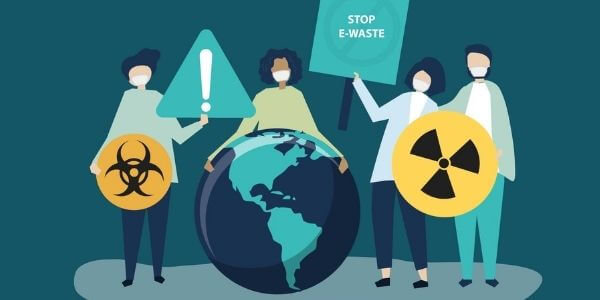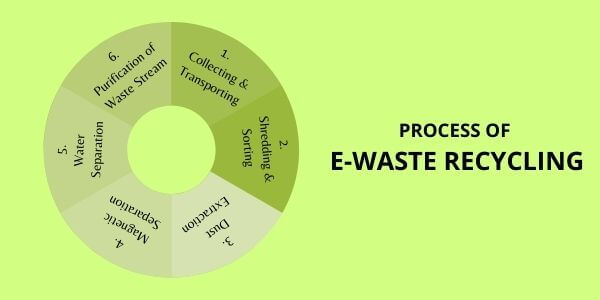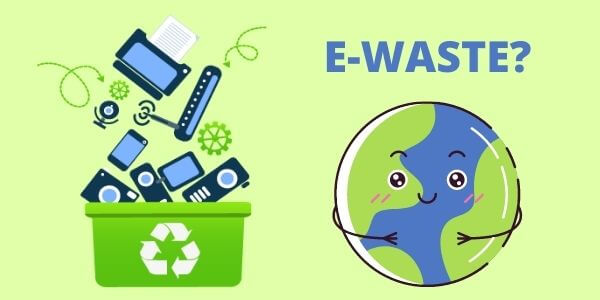The abbreviation “E-Waste” stands for “Electronic or Electrical Waste.” Although the word “e-waste” is used in a broad sense. Toxic substance is present in electrical equipment, and Electronic waste is a global problem. So it is very essential for us to properly manage and recycle the use of electronic waste. So E-waste recycling & E-waste Management is important. Today we cannot imagine our life without electronic devices. So We will discuss here how electronic waste management and recycling are done. If it is not disposable properly, it causes pollution to the environment and harms human health. This topic is crucial for the IAS exam It comes under GS III paper.
What is E-waste?
“Electronic garbage, or e-waste,” according to the International Telecommunication Union, “refers to all items of electrical and electronic equipment and is a portion that has been abandoned as waste by its owner without the goal of re-use. Electronic scrap is a waste that is no longer in use. i.e., Any equipment that is broken, old, device that has expired or damaged. India is the 3rd largest Electronic waste-producing country in the world after China and the USA.
Some examples of electronic waste are Televisions, Computers, Phones, Calculators, Cable, DVDs, etc. New electronic products and new technology have become an important part of our daily life. The creation of innovation brings us comfort, ease, security, information, etc. So there is rapid growth in science and technology. The waste produces from this is hazardous. It is essential for us to manage e-waste properly. It consists of harmful substances like beryllium, cadmium, lead, brominated flame retardants, etc. Gold, copper, silver, and other precious metals can be found in e-waste.
E-waste is Categorized in 21 Types Under 2 Broad Categories
- Information technology and communication equipment. Examples: Cell phones, Smartphones, Computer Monitors, Desktop Computers, Laptops. Circuit boards, Hard Drives, etc.
- Consumer electrical and electronics. Examples: microwaves, heaters, television remotes, remote controls, electrical cords, lamps, smart lights, treadmills, smartwatches, heart monitors, etc.
Here We Have The List of UPSC Free Study Material. Please Don’t forget to check them out.

How is Electronic-Waste Managed
In 2019-2020, India produced more than 10 lakh tonnes of e-waste, according to the Central Pollution Control Board. (CPCB). India has had rules in place to manage e-waste since 2011, requiring that only licenced dismantlers and recyclers collect e-waste. The 2016 E-waste Management Rules went into effect in 2017. In addition, India’s first e-waste clinic opened in Bhopal, Madhya Pradesh, for the separation, processing, and disposal of rubbish from residential and commercial units.
The following are the highlights of the new E-WASTE MANAGEMENT RULES, 2016
The new rules establish stricter standards and reflect the government’s increased commitment to environmental governance.
- CFLs, or Compact Fluorescent Bulbs, are included, as well as other mercury-containing lamps and equipment.
- For the first time, the Rules include producers in the scope of the Extended Producer Responsibility, or EPR, as well as the targets.
- Producers are now responsible for both e-waste collection and e-waste exchange.
- The Compact Fluorescent Lamp (CFL) and other mercury-containing lamps are now subject to the rules.
- The following stakeholders are also included:
- Manufacturers
- Dealers
- Producer Responsibility Organizations and Refurbishers
- The Deposit Refund Scheme was developed as an extra economic tool. When end-of-life equipment is returned, the producer takes an extra amount as a deposit at the time of sale of electrical and electronic equipment, and subsequently returns it to the consumer with interest.
- State governments have also been assigned responsibility for guaranteeing the safety, health, and skill development of personnel involved in dismantling and recycling.
- There is also a provision for a punishment if the rules are not followed.
- Urban Local Bodies (Municipal Committee/Council/Corporation) have been tasked with collecting and diverting orphan products to authorised dismantlers or recyclers.
- Existing and new industrial facilities should have enough room for e-waste breakdown and recycling.
Hotels, residential colonies, bulk producers of consumer products, ports, railway stations, airports, and pilgrimage sites are among the categories targeted by India’s Environment Ministry. This is to ensure that the solid waste generated at their facilities is properly processed and recycled.
NGTs Direction
The National Green Tribunal’s Principal Bench issued orders for the implementation of the E-Waste Management Rules, 2016 earlier this year.
- It stated that there were gaps in collection targets, with 78,000 tonnes of e-waste collected in 2018-19 compared to a target of 1.54 lakh tonnes. On this matter, there are apparent governance deficiencies.
- The CPCB may take actions to comply with Rule 16, which calls for a reduction in the use of hazardous substances in the production of electrical and electronic equipment, as well as their components, consumables, parts, and spares.
- It was observed that there were a large number of incidents occur in residential areas as a result of sloppy e-waste disposal. In such regions, particular attention is required for ongoing vigilance. The CPCB will also have to evaluate and update the e-waste siting regulations, which may take three months.
- To prevent environmental and public health damage and meaningful enforcement of the rule of law, all state pollution control boards must maintain constant vigilance and work with the District Administration at local levels.
The Negative Effects Of E-Scrap
E-waste is hazardous for human health and The environment because of the harmful chemical in it. Electronics contain dangerous compounds, Such as Arsenic, Barium, Cadmium, Lead, Lithium, Silver Brominated dioxins, Polycyclic aromatic hydrocarbons, etc. Therefore when they are no longer wanted or needed, they must be handled with caution.
E-waste is improperly disposed of in landfills or other non-dumping areas poses a significant health risk to present & future generations, as well as the potential for ecosystem poisoning. Toxic substances are generated when electronics are incorrectly disposed of and wind up in landfills, harming the earth’s air, water, soil and, ultimately, human health.
Effects on Human
Human health effects of the substance include damage to the brain, liver, heart, kidneys, and skeletal system. Toxic gases inhalation, heavy metal exposure, and other factors can have a substantial impact on human nervous and reproductive systems, resulting in sickness and birth defects. Improper e-waste disposal is tremendously harmful to the global ecosystem, which is why raising awareness about this growing problem and its potentially disastrous repercussions is vital.
Effects on Environment
Air: Dust particles or chemicals, such as dioxins, are released into the environment when e-waste is disposed of informally by disassembling, shredding, or melting the components, producing air pollution and compromising respiratory health. Burning e-waste raises the risk of chronic diseases and cancers by releasing microscopic particles that can travel thousands of miles, providing serious health risks to humans and animals, and polluting the air.
Water: Other heavy elements present in e-waste, such as mercury, lithium, lead, and barium, drain much deeper into the earth and reach groundwater. After reaching groundwater, these heavy metals eventually find their way into ponds, streams, rivers, and lakes. As a result of these processes, acidification and toxicity are generated in the water, making it unpleasant for animals, plants, and communities even if they are kilometer’s away from a recycling site. Furthermore, it poses a risk to ecosystems.
Soil: E-waste is responsible for about 40% of lead and 70% of other heavy metals found in landfills. Both heavy metals and flame retardants can leak straight from e-waste into the soil when it is placed improperly at ordinary landfills or in places where it is discarded illegally, contaminating underlying groundwater or crops that may be planted locally or in the area in the future.

Recycling Of E-waste
Electronics do not endure forever, what happens to them after they fail? They are sometimes discarded without being re-used. These wastes are sometimes recycled. What is e-waste recycling, you might wonder? What procedures are involved? We’ve got your back.
Process of E-waste Recycling
- Collecting & Transporting: The first step in e-waste recycling is to sort it. Take-back booths or collection bins are set up in designated locations by recyclers. Recyclers carry e-waste to recycling facilities and plants once these bins are full. Batteries in e-waste require special treatment and can be extremely harmful if mixed with other waste.
- Shredding & Sorting: The e-waste will then be shredded and sorted. Shredding is critical to the effectiveness of subsequent separation. This is why, at this point, efficiency is crucial.
- Dust Extraction: A shaking process on the conveyor belt evenly distributes the little waste particles. The fragments of e-waste that have been evenly distributed are then broken down even more. The dust is extracted & disposed in an environmentally responsible manner at this stage.
- Magnetic Separation: Steel and iron can be separated from other wastes with the use of a powerful overhead magnet. You have effectively recycled the steel from the waste stream in this manner.
- Water Separation: Separating glass from plastic requires the use of water separation technology. Glass-containing leads can then be sent to smelters to be used in the manufacture of batteries, x-ray tubes, and new CRTs.
- Purification of Waste Stream: The next step is to locate and extract residual metals from plastics in order to further cleanse the waste stream
Preparing recycled materials for sale is the final stage. Now that the materials have been separated, they can be sold or reused. For some materials, such as steel or plastic, this entails switching to a different recycling stream.
so we have discussed about E-waste management and the process of recycling.

Conclusion – E-Waste
This essay will provide you with in-depth information about E-waste. We have also mentioned E-waste management rules and the recycling process, As well as other important details. As previously stated, it is one of the most important concepts for the IAS exam. As a result, after reading the article, you will have a better understanding of electronic waste.
FAQs – E- Waste
When electrical items are disposed improperly, They have the potential to harm the environment.
Reduce, reuse, and recycle as much as possible. Smart procurement and proper maintenance can help you reduce the amount of e-waste you generate.
E-waste was not mentioned in the Basel Convention (1992), but it was revised in 2006 to include it. It’s an international agreement aiming at minimising cross-border hazardous waste trafficking. It focuses on minimizing hazardous waste transfers, particularly from developed to underdeveloped countries.
Editor’s Note | E-Waste
In conclusion, we have included all relevant information on E-waste, E-waste management, E-waste recycling, and so on in this post. As a result, we recommend that you make a list of all the important points that you can review during the exam. This is a crucial topic for the UPSC exam. Only your dedication and focus will help you achieve the greatest exam scores. So start preparing for your dream goal. Best of luck with your examinations.







